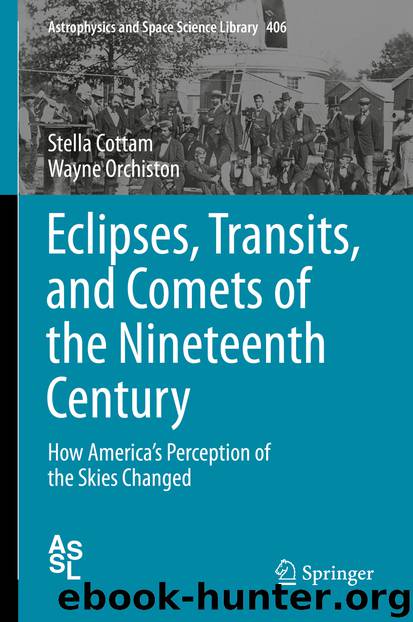Eclipses, Transits, and Comets of the Nineteenth Century by Stella Cottam & Wayne Orchiston

Author:Stella Cottam & Wayne Orchiston
Language: eng
Format: epub
Publisher: Springer International Publishing, Cham
On 24 December there was an article on the many successes of Princeton College that included Professor Young’s expedition to observe the solar eclipse of that year, “… one of the best equipped and one of the most successful.” (Princeton College 1878).
There was little specific mention of the 1878 solar eclipse the following year but articles in The New York Times would demonstrate that there was still a lingering interest among the public in astronomical topics. On 1 March 1879 there was an article on lectures given by John Lockwood on astronomical subjects ranging from the “… wonderful guesses of Kepler …” to the recent use of spectroscopy (Astronomical researches 1879). On 11 and 21 November 1879 there were two items describing a series of lectures on the progress of astronomy, given at Chickering Hall in New York, by England’s ever-popular Richard Proctor to “… a cultured and refined audience, not composed of astronomers.” Proctor discussed topics of interest to the public, such as the habitability of the moon and other planets. He discussed the use of spectroscopy as a tool to understand the nature of the Sun and stars, presenting as examples photographs of several spectra collected by Henry Draper. He predicted a great future for the use of spectroscopy including “… how it might be applied to the determination of the question whether a star is advancing or receding.” (Progress of astronomy, 11 November 1879; Worlds beyond the skies, 21 November 1879).
On 30 April 1879 there was a notice that Lewis Swift, a hardware dealer and amateur astronomer, had been elected as a fellow of the Royal Astronomical Society of England. Swift had been one of the individuals who “… discovered …” an intra-Mercurial planet during his observations of the 1878 eclipse in Denver (Astronomical researches rewarded 1879).
There were a number of articles referring to the conflicting conclusions of Mr Lockyer and Professor Draper on their interpretations of spectra collected during the solar eclipse of 1878. On 7 January 1879 there was an article on a paper presented by Lockyer at a meeting of the Royal Society in London. Lockyer’s comments were preceded by a paragraph on the basics of spectroscopy for the benefit of the interested reader. He explained to his audience how spectroscopy might be used to determine a number of parameters, such as the presence and quantity of particular elements or compounds, as well as the temperature of a star (Nature of the elements 1879). On 14 January 1879 the Times printed an article reporting on the response of some scientists, Professor Henry Draper in particular, to conclusions drawn by Lockyer from spectra collected at the last eclipse. Lockyer had concluded that “… so-called elements are really compound bodies.” He inferred from his observations that the hottest stars have the simple spectra of thick hydrogen lines with very few metallic lines while cooler stars produce lines of “… compounds of metals with non-metals and of non-metals in a state of isolation.” He proposed that heat led to the decomposition of the compounds.
Download
This site does not store any files on its server. We only index and link to content provided by other sites. Please contact the content providers to delete copyright contents if any and email us, we'll remove relevant links or contents immediately.
| Aeronautics & Astronautics | Astronomy |
| Astrophysics & Space Science | Comets, Meteors & Asteroids |
| Cosmology | Mars |
| Solar System | Star-Gazing |
| Telescopes | UFOs |
Tools of Titans by Timothy Ferriss(8218)
Turbulence by E. J. Noyes(7936)
Secrets of Antigravity Propulsion: Tesla, UFOs, and Classified Aerospace Technology by Ph.D. Paul A. Laviolette(5309)
Astrophysics for People in a Hurry by Neil DeGrasse Tyson(5131)
Room 212 by Kate Stewart(5035)
Design of Trajectory Optimization Approach for Space Maneuver Vehicle Skip Entry Problems by Runqi Chai & Al Savvaris & Antonios Tsourdos & Senchun Chai(5011)
Pale Blue Dot by Carl Sagan(4912)
The David Icke Guide to the Global Conspiracy (and how to end it) by David Icke(4625)
A Journey Through Divination and Astronomy by Publishing Pottermore(4344)
Goodbye Paradise(3727)
Apollo 8 by Jeffrey Kluger(3637)
COSMOS by Carl Sagan(3554)
Losing the Nobel Prize by Brian Keating(3498)
The Five People You Meet in Heaven by Mitch Albom(3475)
How to Read Water: Clues and Patterns from Puddles to the Sea (Natural Navigation) by Tristan Gooley(3406)
Brief Answers to the Big Questions by Stephen Hawking(3369)
How to Read Nature by Tristan Gooley(3249)
The Order of Time by Carlo Rovelli(3145)
A Brief History of Time by Stephen Hawking(2960)
